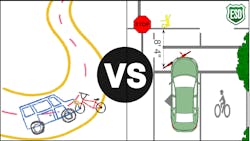Bad Diagrams' Hidden Cost: How Outdated Diagramming Practices Impact Prosecutions, Waste Resources and Hurt Efficiency
By Aaron Baumert, Global Director of Sales at SmartSafety Software
In law enforcement, accuracy isn’t optional, it’s the bedrock of effective policing. Whether it’s documenting a vehicle crash, mapping a crime scene, or preparing an operational plan, the ability to produce a precise, to-scale diagram can mean the difference between a solid prosecution and a failed case.
Yet, despite decades of technological advancement, many agencies still rely on outdated diagramming practices. These range from hand-drawn sketches in notebooks to underpowered software that forces officers into hours of manual work. The result? Slower case processing, inconsistent documentation, and, worst of all, avoidable challenges in court.
In this article, we’ll explore the real-world costs of bad diagrams, from wasted officer hours to lost prosecutorial opportunities, and offer practical steps for law enforcement leaders to modernize their scene documentation practices.
The Real Stakes of Scene Diagrams
Scene diagrams are not just a box to check in a report; they’re often the visual anchor of an entire case. A clear, accurate diagram can:
- Help prosecutors explain complex incidents to a jury.
- Support officers’ testimony with visual reinforcement.
- Provide investigators with a reliable reference for reconstructing events.
When diagrams are sloppy, incomplete, or inconsistent, those benefits vanish. Inaccuracies can raise doubts in court, slow down case reviews, and even create openings for defense challenges.
The Common Pitfalls of Outdated Practices
1. Inconsistent Scales and Measurements
A hand-drawn diagram might capture the general scene, but without standardized scaling, distances and spatial relationships are open to interpretation. This lack of precision can undermine an investigator’s credibility and lead to disputes over evidence placement.
2. Time-Intensive Manual Work
Officers spend valuable hours drawing roads, buildings, and intersections, time that could be spent on active patrols or investigative follow-up. In some agencies, officers still carry rulers and graph paper for this purpose. The delay in processing can slow case movement through the judicial system.
3. Lack of Standardization Across the Department
When each officer creates diagrams in their own style, the results vary widely. For supervisors and prosecutors, this inconsistency makes it harder to compare cases, train new staff, and maintain operational efficiency.
4. Limited Integration with RMS and Reporting Systems
If diagramming is performed outside the agency’s primary reporting tools, staff must re-enter data or upload files manually. This duplication wastes resources and increases the risk of lost files or mismatched records.
The Ripple Effect on Prosecutions
Poor-quality diagrams aren’t just an internal frustration; they can jeopardize an entire case. Prosecutors may find it harder to establish a clear narrative when the visual evidence is ambiguous.
Imagine a felony assault trial hinging on the exact position of individuals and vehicles. If the diagram is vague or distorted, defense attorneys have an open invitation to sow doubt. In civil litigation, such as a disputed crash liability case, unclear diagrams can mean the difference between a favorable settlement and an expensive loss for the municipality.
The Operational Cost to Agencies
Beyond courtrooms, outdated diagramming practices create ongoing operational inefficiencies:
- Officer Burnout – Adding hours of diagramming work to already packed shifts erodes morale.
- Training Overhead – Without standardized tools, training new recruits in scene documentation becomes a repetitive and inefficient process. Delayed Investigations – If diagrams require specialist review or corrections, investigations stall.
- Over time, these inefficiencies compound into a measurable loss of productivity and increased overtime costs.
Moving Toward Modernization
Law enforcement executives have an opportunity to significantly improve efficiency and case quality by modernizing their diagramming processes. Key steps include:
1. Audit Current Practices
Survey officers and supervisors about their current workflow for scene diagrams. Identify common pain points, bottlenecks, and error patterns.
2. Standardize Formats and Procedures
Adopt a consistent set of symbols, scales, and labeling conventions. This ensures that any officer’s diagram can be interpreted quickly and accurately by colleagues, prosecutors, and the courts.
3. Prioritize Integration
Look for diagramming solutions that integrate directly into your RMS or crash reporting system. Eliminating the need to jump between platforms reduces data loss and shortens the reporting process.
4. Support Field-Friendly Features
Modern solutions should work offline, generate to-scale diagrams quickly, and offer templates for both crash and non-crash incidents. This allows the same tool to be used for tactical planning, event security, and other scenarios beyond traffic collisions.
Lessons from Agencies That Made the Switch
Agencies that have transitioned from manual diagramming to integrated, modern solutions consistently report:
- Time Savings – Diagrams that once took an hour to create can be completed in minutes.
- Improved Court Outcomes – Consistent, professional diagrams bolster case credibility.
- Higher Officer Satisfaction – Tools that reduce tedious work free officers to focus on public safety.
For one mid-sized municipal police department, standardizing diagramming reduced average report completion time by 20%, allowing the agency to reallocate hundreds of hours annually to proactive policing.
Recommendations for Executives
For leaders evaluating an upgrade to their diagramming capabilities, consider the following best practices:
- Involve End-Users Early – Patrol officers, investigators, and supervisors will identify practical needs that decision-makers might overlook.
- Plan for Training – Even intuitive tools benefit from short, hands-on sessions to speed adoption.
- Evaluate Total Cost of Ownership – Include not just licensing, but also the potential reduction in overtime, improved case outcomes, and operational efficiencies.
Conclusion
Bad diagrams are more than a minor inconvenience, they’re a liability. Inconsistent, time-consuming, and poorly integrated diagramming practices drain resources, hurt efficiency, and can weaken prosecutions.
By investing in standardized, modern solutions that integrate with agency systems and work in real-world conditions, law enforcement leaders can improve both operational performance and case outcomes. The benefits ripple across the organization, from reduced officer burnout to stronger courtroom presentations.
In an era where every minute and every detail matters, the cost of bad diagrams is one no agency can afford.
About the Author
Baumert has over 25 years of experience as a trainer and sales consultant for International, Federal, State and Local agencies with a focus on software and hardware technologies used by law enforcement and military communities. Responsible for deploying technology offerings as well as conducting classes and seminars for all facets of military and law enforcement agencies as well as P.O.S.T certified classes. He is a Charter member of the All-Hazards Incident Management Teams Association (AHIMTA) and an associate member of the International Association of Bomb Technicians & Investigators (IABTI), a member of the NATO Explosive Ordinance Disposal Center of Excellence and a member of the Association of Transportation Information Professionals (ATSIP).

